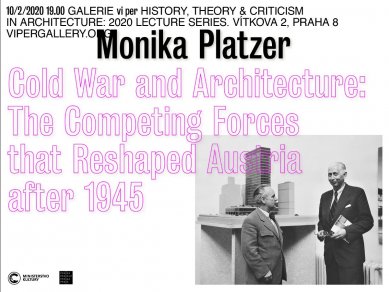
Monika Platzer: Cold War and Architecture - lecture at the VI PER gallery
The Competing Forces that Reshaped Austria after 1945
Source
Galerie VI PER
Galerie VI PER
Publisher
Tisková zpráva
10.02.2020 06:30
Tisková zpráva
10.02.2020 06:30
Lectures
Czech Republic
Prague
Karlín
Galerie VI PER invites you to a lecture by Monika Platzer.
After the liberation of Austria in the spring of 1945 and the appropriation of territory by the four victorious powers – Great Britain, France, the USA, and the Soviet Union – Vienna became the central stage of the Cold War. Unlike Germany, Austria is generally not perceived as a battleground for politicized debate about architecture during the Cold War. During its occupation, Austria transformed from an authoritarian government system into a democratic consumer society. Following the liberation by Allied forces, each of the four occupying powers brought its own diverse cultural program to the country. Great Britain, France, the United States, and the Soviet Union used architecture exhibitions as a platform for cultural, ideological, economic, and technological transfer. The exhibited architectural works and the accompanying discourse became tools of an “educational program” for the creation of a new world and social order, reflecting the global rivalry of the Cold War.
The cultural-political measures of the victors became a catalyst for their ideological thinking. Research into the cultural campaigns of all four occupying powers reveals their different approaches. Alongside the respective political interests of the Allied forces, their cultural activities aimed at influencing various target groups. These measures, however, clashed with local traditions, heterogeneous interest groups, and networks that utilized cultural transfer and the conflicting potential of the Cold War for their own professional development.
The lecture is a call to anchor a transnational perspective on national narratives, emphasizing the need to transform the canon of views on post-war architectural history.
Monika Platzer studied art history at the University of Vienna. She works as a curator at the Architekturzentrum Wien (AzW) and heads its collection department. Her research focus is on the cultural history of the 20th century. Her experience also includes international curatorial work at leading institutions such as the Canadian Centre for Architecture (CCA) and the Getty Research Institute (GRI). Notable exhibitions she has organized include: 'Vienna. The Pearl of the Reich.' Planning for Hitler (2005); a_show: Austrian Architecture in the 20th and 21st Centuries (AzW, permanent exhibition); Lessons from Bernard Rudolfsky (2007–2008); Kinetism. Vienna Discovers the Avant-Garde (2006); and Shaping the Great City: Modern Architecture in Central Europe 1890–1937 (1999–2001). Monika Platzer teaches at the University of Vienna and the Vienna University of Technology; she is an editor of the journal icamprint, published by the International Confederation of Architectural Museums. In 2014, she was a visiting fellow at the Center for European Studies at Harvard University. Her current research focuses on transnational architectural history.
After the liberation of Austria in the spring of 1945 and the appropriation of territory by the four victorious powers – Great Britain, France, the USA, and the Soviet Union – Vienna became the central stage of the Cold War. Unlike Germany, Austria is generally not perceived as a battleground for politicized debate about architecture during the Cold War. During its occupation, Austria transformed from an authoritarian government system into a democratic consumer society. Following the liberation by Allied forces, each of the four occupying powers brought its own diverse cultural program to the country. Great Britain, France, the United States, and the Soviet Union used architecture exhibitions as a platform for cultural, ideological, economic, and technological transfer. The exhibited architectural works and the accompanying discourse became tools of an “educational program” for the creation of a new world and social order, reflecting the global rivalry of the Cold War.
The cultural-political measures of the victors became a catalyst for their ideological thinking. Research into the cultural campaigns of all four occupying powers reveals their different approaches. Alongside the respective political interests of the Allied forces, their cultural activities aimed at influencing various target groups. These measures, however, clashed with local traditions, heterogeneous interest groups, and networks that utilized cultural transfer and the conflicting potential of the Cold War for their own professional development.
The lecture is a call to anchor a transnational perspective on national narratives, emphasizing the need to transform the canon of views on post-war architectural history.
Monika Platzer studied art history at the University of Vienna. She works as a curator at the Architekturzentrum Wien (AzW) and heads its collection department. Her research focus is on the cultural history of the 20th century. Her experience also includes international curatorial work at leading institutions such as the Canadian Centre for Architecture (CCA) and the Getty Research Institute (GRI). Notable exhibitions she has organized include: 'Vienna. The Pearl of the Reich.' Planning for Hitler (2005); a_show: Austrian Architecture in the 20th and 21st Centuries (AzW, permanent exhibition); Lessons from Bernard Rudolfsky (2007–2008); Kinetism. Vienna Discovers the Avant-Garde (2006); and Shaping the Great City: Modern Architecture in Central Europe 1890–1937 (1999–2001). Monika Platzer teaches at the University of Vienna and the Vienna University of Technology; she is an editor of the journal icamprint, published by the International Confederation of Architectural Museums. In 2014, she was a visiting fellow at the Center for European Studies at Harvard University. Her current research focuses on transnational architectural history.
The English translation is powered by AI tool. Switch to Czech to view the original text source.

0 comments
add comment
Related articles
0
26.11.2022 | Tao DuFour: Husserl and Spatiality - lecture at the VI PER gallery
0
11.03.2019 | Philip Ursprung: Political Landscape
0
10.12.2018 | Marie-Christine Schoel: Enfolding/Unfolding
0
02.11.2018 | Martino Stierli: Montage et la Métropole
0
02.11.2018 | Samia Henni: Architecture of Counterrevolution
0
03.06.2016 | Spyros Papapetros: Retrouver le champ élargi












